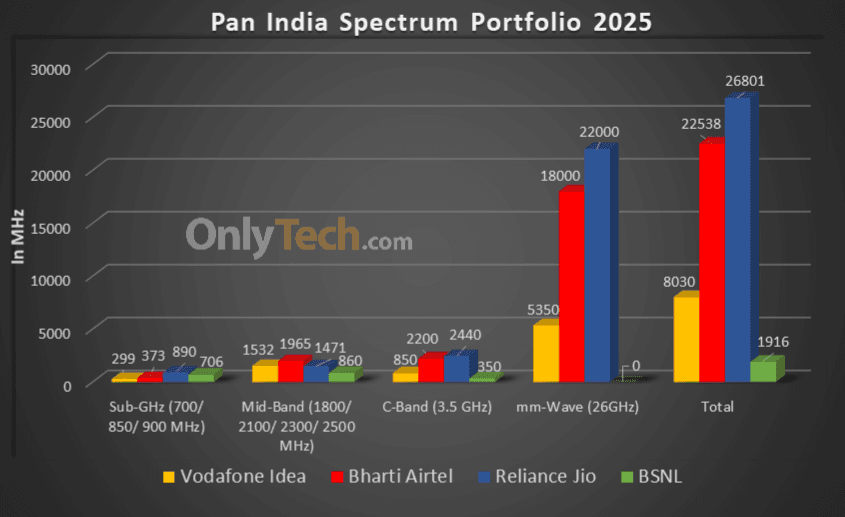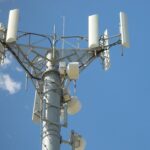Spectrum is for telecommunication what jet fuel is for aviation. Spectrum is a range of electromagnetic frequencies or airwaves that telecom companies use for establishing a connection between a cell tower and a mobile phone. The bandwidth of this spectrum is directly proportional to the speed of a wireless data network (since more data can be transmitted simultaneously through a broader data pipeline). In contrast, the frequency is inversely proportional to the coverage (since lower frequencies penetrate better through physical barriers and thus have wider coverage).
The spectrum holding data sheet embedded in this article represents the current spectrum holdings of all active telecom operators across all frequency bands across all 22 telecom circles along with their liberalisation status and expiry dates. All figures represented are in MHz. The value mentioned in the bracket beside the frequency at the base of each sheet is the band number where ‘B’ stands for 4G LTE band whereas ‘n’ stands for the corresponding 5G NR band.
The spectrum shown under BSNL and Aircel in white is reserved for the respective operators but has not yet been officially allotted to them.
Spectrum Liberalisation:
Spectrum was administratively allocated to operators in each of the 22 licensed service areas or circles prior to 2010, this spectrum is called non-liberalised and can only be used for 2G services whereas all airwaves allotted post-2010 have been through a Spectrum Auction where operators have paid the market discovered price and this spectrum is called liberalised and can be used for any technology platform 2G/3G/4G/5G. Alternatively, operators may choose to liberalise their administratively allotted spectrum by paying the market-discovered price to DoT on a pro-rata basis for the remaining validity of the spectrum.
Paired and Unpaired spectrum:
Spectrum may be paired or unpaired, bands 1/3/5/8/28 are all paired where one set of frequencies is used for uplink whereas another distinct set of frequencies is used for downlink known as Frequency-division duplexing (FDD), whereas bands 40/41/78/258 are unpaired where both uplink and downlink happens in the same set of frequencies separated by the time of uplink and downlink known as Time-division duplexing (TDD).
List of Indian FDD Bands:
| 4G LTE band | 5G NR band | Uplink frequency range (MHz) | Downlink frequency range (MHz) | Bandwidth for telecom (MHz) | Block size (MHz) |
|---|---|---|---|---|---|
| B1 | n1 | 1939-1979 | 2129-2169 | 40×2 | 5×2 |
| B3 | n3 | 1710-1780 | 1805-1875 | 70×2 | 0.2×2 |
| B5 | n5 | 824-844 | 869-889 | 20×2 | 1.25×2 |
| B8 | n8 | 890-915 | 935-960 | 25×2 | 0.2×2 |
| B28 | n28 | 723-733/ 738-748 | 778-788/ 793-803 | 20×2 | 5×2 |
List of Indian TDD Bands:
| 4G LTE band | 5G NR band | Frequency range (MHz) | Bandwidth for telecom (MHz) | Block size (MHz) |
|---|---|---|---|---|
| B40 | n40 | 2300-2380 | 80 | 10 |
| B41 | n41 | 2535-2555/ 2615-2655 | 60 | 10 |
| – | n78 | 3300-3670 | 370 | 10 |
| – | n258 | 24250-27500 | 3250 | 50 |
Spectrum caps:
A spectrum cap dictates how much spectrum a particular operator can hold in a circle for a specific band. There is a 40% cap for Sub-GHz spectrum in the 700/850/900 MHz bands combined, a 40% cap for Mid-Band spectrum in the 1800/2100/2300/2500 MHz bands combined, a 40% cap for the C-Band spectrum of 3300-3670 MHz and a 40% cap for the mm-Wave spectrum bands of 24.25-27.5 GHz. The current spectrum caps are denoted in the spectrum chart.
Overall spectrum holdings of operators (in MHz):
| Operator/Holding | Jio | Airtel | Vi | BSNL |
|---|---|---|---|---|
| Sub-GHz | 890 | 373.2 | 298.8 | 706 |
| Mid Band | 1470.8 | 1964.9 | 1531.6 | 860 |
| C-Band | 2440 | 2200 | 850 | 350 |
| mm-Wave Band | 22000 | 18000 | 5350 | 0 |
| Total | 26,800.8 | 22,538.1 | 8,030.4 | 1,916 |
Spectrum sharing/trading/leasing guidelines:
- Telecom operators holding CMTS/UASL/UL licenses can enter into a Spectrum-Sharing agreement with each other so long as both parties hold liberalised spectrum in the same band in the same circle. Spectrum sharing is possible only on a Pan LSA level in block sizes defined by DoT and only after one year of an operator acquiring the spectrum.
- Telecom operators holding CMTS/UASL/UL licenses can enter into a Spectrum-Trading agreement with each other so long as the spectrum being sold is liberalised. Trading of spectrum is possible only on a Pan LSA level in block sizes defined by DoT and only after two years of an operator acquiring the spectrum.
- Telecom operators may enter into a Spectrum-Leasing agreement only with Enterprises holding a Captive Non-Public Network (CNPN) license and not with each other. The lease may be limited to any geographic area within the LSA and for any duration mutually agreed upon by both parties. A CNPN licensee can lease spectrum from multiple operators within an LSA.
Note: We update this chart in real-time to ensure it is always up to date with the latest changes in spectrum holding. Certain human errors might have crept in during the manual compilation of the data, any mistakes/ rectification can be brought to the Team’s notice through the comments section below.








@Esmail Bro: On Saral Sanchar portal after analyzing I find that Jio’s and RCOM’s Band 3 (1800) holdings in Jammu & Kashmir, North East and Odisha are contiguous with each other and they both can easily form a single contiguous block of 15 mhz in Band 3 (1800) for the above mentioned 3 circles. Has Jio deployed 15 mhz bandwidth in Band 3 (1800) in the above mentioned 3 circles ? Now my question to you is does Jio have any spectrum sharing agreement with RCOM for Band 3 (1800) also (in above mentioned 3 circles) ?
Saral Sanchar does not reveal the name of the operator whose spectrum holding is represented in the chart, it just shows the spatial arrangement of the blocks. With 800 MHz band, it was easy to determine since there are limited operators there and using the provisional frequency allotment and expiry dates it was easy to decipher. In 1800 MHz multiple operators had bid for spectrum in the 2015 2016 period and the harmonisation activity may have shifted them around, for example in Jammu Kashmir circle where Jio has a 10 MHz chunk, the other 5 MHz block which is contiguous with it could either be Rcom or Vi. So only when Saral Sanchar starts to display operator names with the holdings can we be sure about it.
And no, Jio does not have any spectrum sharing agreement with Rcom in band 3 anywhere in India.
@Esmail Bro: Yes Saral Sanchar does not display operator name. But after careful comparison using your Pan India Spectrum holding chart and the data available on Saral Sanchar you can easily conclude the same (which I told). Also by comparing the expiry date from your chart and Saral Sanchar you can easily conclude the same. Also data in B3 (1800) is mostly shown in serial wise manner (operator wise) and mostly in contiguous way. Also if you see 10 mhz (2016 auction) for J&K is directly shown on Saral Sanchar and no other operator bidded for 10 Mhz B3 (1800) in 2016 in J&K. Just try to compare once using your chart and data available on Saral Sanchar portal you would easily understand what I am trying to say. Just try looking by expiry date (mostly its serial wise by operator and DOT in most cases allots each operator contiguous blocks only). Also DOT would most probably allot contiguous blocks to VI in J&K. Also the 5 mhz blocks for VI for 2016 auction would always be contiguous with the other blocks (2026 and 2032 expiry). So you can easily decipher from the data available on your chart and Saral Sanchar portal. Try once.
@esmail why there frequency of a particular bands changes from one circle to another. Like in case of Airtel 4G : Bihar b3 uplink – 1741 and downlink – 1836 and in up east uplink – 1717.6 and downlink – 1812.6 . Observed same trend in all bands. Why it is so ?
different operators buy spectrum in different circles at different times in different auctions and DoT gives them the won spectrum as and when that happens. DoT cant reserve the same frequency slot for an operator in one circle just because it won it in another circle. say if Jio won a 5 MHz block in Haryana but didn’t choose to bid in Punjab and Airtel did bid for a 5 MHz block in Punjab, DoT cant say that it is reserving that block for Jio and not give it to Airtel, hoping that Jio will bid for it in the next auction. Though if Jio does bid for it in the next auction then DoT will allot it the next available block and not ask Airtel to shift its allotment unless it is for the purpose of harmonisation and to make all operators spectrum holdings in a band contiguous.
Thank you